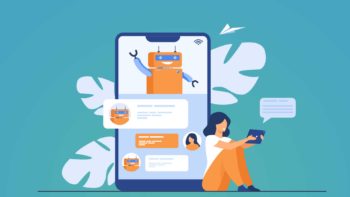4 Basic Questions Every Chat Bot Has To Know Answer To

Table of Contents
Creating a chatbot for your small business or brand is akin to wrapping a present and handing it out to the general public. Initially, you're full of excitement, daydreaming about all the wonderful questions your site visitors may ask the new chatbot. But then… the reality comes in.
Most people tend to go haywire when they interact with chatbots and ask questions that will have your chatbot saying: "I'm sorry, I don't understand that command". Well, we have good and bad news.
The bad news is that site visitors will never stop asking absurd questions. However, the good news is that we have listed the basic questions your chatbot should know answers to. These questions are drawn from data, research, and a few therapy sessions with some traumatized chatbots.
Whether you run a college essay writing service or an e-commerce brand, these questions will help you equip your chatbot with valuable input information and answers.
What Is a Chatbot?
Before we go into details, it's important to answer one burning question that any beginner might ask: what are chatbots anyway?
A chatbot is a software application used by brands and businesses to conduct online conversations with customers or site visitors. It serves as a human agent that answers any questions visitors may have and supplies them with the necessary information.
In today's world, chatbot architecture is a welcome trend as it saves companies financial and human resources that may be expended when trying to hire live agents.
Why Does Your Business Need a Chatbot?
Chatbots are like plants for businesses - they help make sure you've got the business in control and thriving. But that's not all they do. In today's ever-evolving technological world, your business needs a big bot for the following reasons:
To maximize the capacity of your operations
Although human agents offer a more personal and emotional experience for customers, the human factor poses a tiny disadvantage. Human agents tend to encounter physical limitations such as tiredness or burnout. In the same vein, they can only attend to about two or three queries at the same time (four, if they are superb multitaskers).
On the other hand, chatbots can interact with as many customers as you like without fizzling out. There are no limitations to their operations. As such, adding this new technology to your workforce can greatly boost performance and maximize your operational capacity.
To act as the first point of contact
Whether you're a small business trying to break into the market or you own a well-established company, you're definitely going to get a large number of queries from site visitors. From people who want to know more about the business to customers asking mundane questions, the load can be overwhelming. In fact, your human agents will most likely prefer to deal with complicated questions rather than sift through typical questions.
Well, this is where chatbots come in. They can act as your first point of contact, answering any basic questions that customers may have. If the customer in question asks a complicated question, they can then be redirected to a human agent.
To help millennials figure things out
In today's world, most brands target millennials as their audience, and for good reasons. Research has shown that millennials make up 22 percent of the media audience. Even if your product is specifically created for seniors, there's a huge chance that your site will be clogged by millennials trying to purchase the product for their aged parents.
Here's one thing that should be noted: millennials do not care much for impulse buying. Usually, they ask several questions about the product's use, side effects, and eco-friendliness before buying. Since most millennials prefer to ask these questions via live chat rather than phone calls, it's important to set up chatbots that can efficiently respond to their inquiries.
To save your money
According to recent studies, chatbots currently save businesses about $20 million globally and this figure is expected to increase astronomically by 2022. But how exactly do chatbots do this?
To begin with, this futuristic, cutting-edge technology lowers labor expenses by eliminating the need for hiring too many human agents. In the same vein, they increase customer satisfaction, thereby raising the possibility of customer retention and conversion.
Questions Your Chatbot Should be Prepared For
If you're looking to release your new chatbot into the world, here are some questions you should prepare it for:
What do you do?
Customers will always be interested in learning more about what your business does and what your services entail. What exactly is the purpose of your company and brand? Your chatbot should be able to answer this question engagingly, making sure no details are left out.
During the bots programming process, you could offer variations of the same answer to make your bot sound less mechanical and more human.
How does it work?
This is yet another frequently asked question that your chatbot needs to be prepared for. Site visitors will definitely have a lot of questions on how the order process works or how to use your product or service. As such, you should make sure your bot can address this question even if you've already created an in-depth onboarding guide for site visitors.
Pro Tip: if you feel like your customers may need further information, you could host a webinar using any reliable virtual events platform and answer all questions that may be too complicated for your bot.
How are you?
Although your chatbot is literally a robot, it doesn't necessarily have to sound like one by giving mechanical answers all the time. Occasionally, your bot may get questions like how are you or what's up. In cases like this, you can come up with a creative answer that reflects the fun side of your brand persona.
A great answer could be: "I'm great, but I'd give up my microchips for a massage session right now".
Where are you based?
Often, your customers may have questions about the locations and regions you cater to. If you sell physical products, this is one question you definitely should not overlook. Your bot's answer should include a list of the locations you cater to, the ones you don't, as well as the reasons why you don't ship to those regions. This will help ensure that your customers don't get confused or disappointed.
Final Thoughts
Although there is an endless list of questions that your chatbot should know the answers to, the ones outlined above will set you off to a great start. Don't forget to get as creative as possible with your answers to give your customers a more personalized user experience.
Share this article



